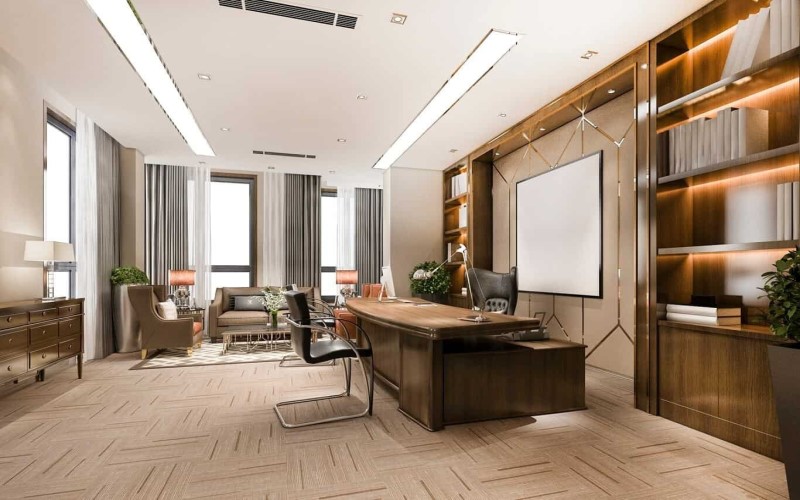In today’s fast-paced business environment, a disorganized office can negatively impact productivity and morale. Cluttered spaces lead to wasted time and increased stress. This article discusses the challenges of disorganized offices and highlights design principles, successful examples, and practical tips for creating efficient work environments that boost individual and team performance.
The Challenges of Disorganized Office Spaces
Disorganized office spaces present several challenges that can negatively impact a business’s operations. Clutter and poorly designed layouts can lead to:
- Reduced Productivity: Employees spend more time searching for documents, tools, and information, leading to decreased efficiency.
- Increased Stress: Cluttered and chaotic environments can cause stress and anxiety, affecting overall well-being and job satisfaction.
- Poor Communication: Inefficient layouts can hinder collaboration and communication among team members, leading to misunderstandings and delays.
- Safety Hazards: Disorganized spaces may pose safety risks, such as tripping hazards or blocked emergency exits.
Addressing these challenges through thoughtful office design is essential for creating a productive and positive work environment.
Key Design Principles for Creating Efficient Work Environments
1. Ergonomic Design
Ergonomic design focuses on creating a workspace that supports the physical well-being of employees. Adjustable chairs, sit-stand desks, and properly positioned monitors can reduce the risk of musculoskeletal issues and fatigue. Ergonomic workstations also enhance comfort, enabling employees to maintain focus and productivity.
2. Optimal Layout and Space Utilization
An efficient office layout maximizes space utilization while promoting smooth workflow and easy access to essential tools and resources. Open floor plans with designated zones for different activities, such as collaborative work, individual tasks, and relaxation, can enhance efficiency. Private areas for focused work and quiet zones are equally important to minimize distractions.
3. Effective Storage Solutions
Implementing effective storage solutions helps keep the workspace organized and clutter-free. Shelving units, filing cabinets, and storage bins ensure that everything has its place. Encourage employees to regularly declutter and organize their workstations to maintain an orderly environment.
4. Technology Integration
Incorporating technology into the office design can streamline operations and improve efficiency. Smart systems for lighting, climate control, and security can create a more comfortable and secure environment. Additionally, providing high-speed internet and advanced communication tools ensures that employees have the resources they need to work effectively.
5. Natural Light and Acoustics
Natural light has been shown to improve mood and energy levels, enhancing overall productivity. Design the office to maximize natural light while using artificial lighting to supplement as needed. Managing acoustics is also crucial; soundproofing materials and designated quiet zones can reduce noise distractions and improve concentration.
The Impact of Organized Spaces on Employee Productivity and Morale
Organized office spaces have a profound impact on employee productivity and morale. An efficient workspace:
- Boosts Productivity: Employees can focus on their tasks without the distraction of clutter or the frustration of searching for tools and documents.
- Enhances Well-being: A clean, organized environment reduces stress and promotes a sense of calm and control.
- Improves Collaboration: Efficient layouts facilitate better communication and teamwork, leading to more effective problem-solving and innovation.
- Increases Job Satisfaction: Employees in well-designed spaces feel valued and supported, leading to higher engagement and job satisfaction.
Practical Tips for Designing an Office That Maximizes Efficiency
1. Conduct a Needs Assessment
Assess the current workspace and identify areas for improvement. Consider the specific needs of your team and the types of tasks they perform. Gather feedback from employees to understand their preferences and pain points.
2. Plan for Flexibility
Design a workspace that can adapt to changing needs and future growth. Use modular furniture and flexible layouts to accommodate different work styles and tasks.
3. Implement Effective Storage Solutions
Invest in storage solutions that keep the workspace organized, like office desks available in Las Vegas. Encourage employees to regularly declutter and maintain their workstations.
4. Maximize Natural Light
Design the office to take advantage of natural light. Use transparent or translucent partitions to allow light to flow through the space.
5. Prioritize Ergonomics
Provide ergonomic furniture and equipment to support employee health and comfort. Regularly review and update ergonomic standards to ensure they meet the needs of your team.
Conclusion
Transforming a chaotic office into a well-organized, efficient workspace is vital for boosting productivity and employee morale. By applying key design principles and practical tips, businesses can create environments that support their teams and drive success. Focusing on ergonomics, effective layouts, and technology integration will result in a more productive and satisfied workforce.

